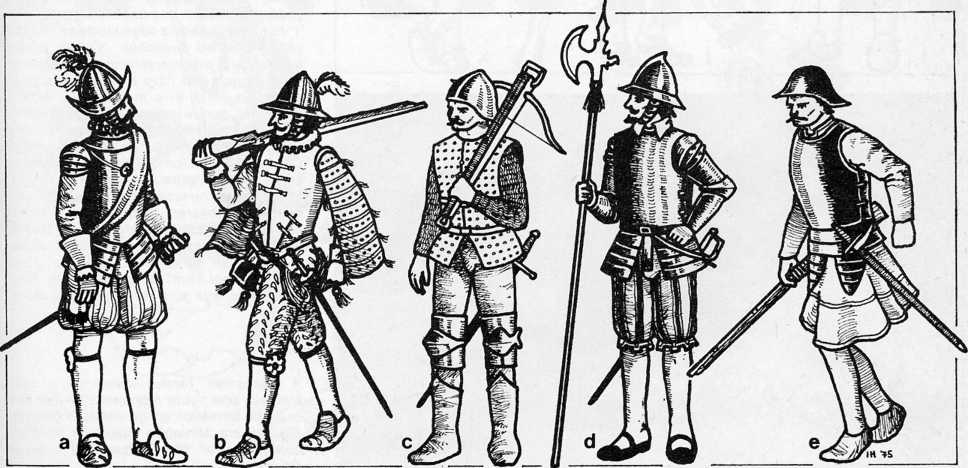Spain was vet7 definitely the dominant military power of 16th Century Europe, primarily because her troops were the only real ‘regulars’ west of the Ottoman Empire—‘regular’, that is, in the sense that they alone were permanently employed, since Spain was permanently at war. Spanish forces alone provided anything like a proper career-structure for officers, for the same reason, and, partly for this reason, enjoyed the best generalship of the period. Spanish armies of the 16th Century acted as models and training schools for many others.
Spanish commitments were as great as Spanish wealth, and her troops fought in Spain itself, Oran and Tripoli, Italy, Ireland, France, Central and South America, and above all, in the Low Countries, under Spanish control from 1519. Under Charles V (1519-58), Spain and the Holy Roman Empire were temporarily united, and even into the 17th Century Spanish forces co-operated with Imperial ones; Franco-Dutch-Spanish conflict was renewed through the 30 Years’ War period. However, by this time, the economic and political decline of Spain was sapping the strength and morale of her troops, and fheir deterioration was high-nieSmm
Lighted by the disaster of Rocroi (1643), a defeat, at French hands, from which Spanish military power never recovered.
Their Catholic Majesties, Ferdinand of Aragon and Isabella of Castille, undertook, at the end of the 15th Century, a thorough reorganisation of the rather heterogenous forces of their newly-united kingdom, and it was from this that the 16th Century Spanish army sprang.
The main force for home defence and the support of the Civil Power was the militia of the fortified cities, the Hermanadad (Brotherhood), which included both cavalry and infantry. It was reorganised into battalions of ten 50 man companies each, those of Andalusia (1490) having seven per cent with firearms, 33V3 per cent crossbowmen, 42 per cent spearmen or pikemen, and the rest pioneers and craftsmen. A sort of uniform was worn, consisting of a white woollen over-tunic with a hood, sleeves tight at thetop but flaring out widely from the elbow, and a red cross back and front. Trousers (probably tight hose) were also red; boots or sandals were worn. Helmets were commonly of sallet type, much favoured in Spain (and, indeed, generally) at this time. Provincial militia served throughoutthe period, mainly against rebellions — in 1567 they were 33V3 per cent crossbowmen, 66% per cent arquebusiers, while the cavalry had lances.
A standing army under fuller royal control was started in the 1490s with Gendarmerie (see below) and Constabulary ‘of the Ordinance’, on Burgundian lines. The latter were infantry, formed in 100 man companies, and probably similar to the Hermanadad troops in appearance. One-third were pikemen (modelled on Swiss mercenaries), one third Aragonese sword-and-buckler men, and one-third crossbowmen and arquebusiers.
Once an army was created, and the Moors finally conquered (1492), a more active foreign policy was possible, and the Spanish armies first began to make their mark in Europe in the early Italian wars, under the great Gonzalo de Cordoba.
A high proportion of this expeditionary force were crossbowmen, and there were still many sword-and-buckler men, but the former were steadily replaced by arquebusiers, and the latter, despite the striking success against pikes mentioned in Chapter 2, by pikemen, who had some chance of standing in the open against cavalry. Infantry firepower — the first use of massed arquebusiers — combined with skilful use of field fortifications, was, however, the key to early Spanish success.
Contemporary drawings of Tercio formations.
A Officer, late 16th or early 17th Century, wearing half armour, ornate morion with plumes probably red-white-red, and red sash. Rapier has a round guard, b Late 16th or early 17th Century arquebusier wearing morion, hanging sleeves and knee-length baggy trousers. Note tasselled pouches and match on belt, c Crossbowman, late 15th or early 16th Century. He wears tight hose, studded brigantine with mail sleeves, sallet helmet, plate protection at knees and Moorish boots. Pikemen, swordsrnen and arquebusiers could be similar, d Sergeant of a Tercio, 1534. Pikemen would be similar, e Arquebusier in sallet, corselets and short tassets, early 16th Century. He wears a long-skirted tunic over hose and soft shoes, and could have had shoulder and elbow protection as well, or no armour at all. Again, pikemen could be similar.
Spanish officer of the iater 16th Century, probably around 1580.

The troops were divided into ‘Colunelas’ (columns) under ‘Coronels’, at first of about 600 men in three ‘squadrons'. In 1505, 20 Colunelas, of 1,000 to 1,500 men each, in four or five ‘banderas’, were established. These were predominantly of pikemen and arque-busiers, but included a few halberdiers and up to perhaps 20 per cent sword-and-buckler men.
The infantry still wore close fitting hose from the waist down, often with calf-high Moorish boots of red Morocco leather; a tunic with a very wide and long skirt might also be worn. Even an arquebusier could wear a plate corselet, but mail shirt, studded brigantine, or plain leather jerkin was a more usual type of protection. Nearly all seem to have had helmets, simple sallets, burgonets, or cabacete morions. Red was a popular colour, and scarlet military cloaks are mentioned. A picturesque unit in Gonzalo’s army was the negro guard of the field-treasury, clad in fuschia-blue cloaks (there were field-forges, field-mills, and even travelling altars as well).
As in later years, the Spanish infantry were supplemented by mercenaries — mainly Italian skirmishers with arquebusses, and Germans with pike or arquebus. There was even a‘secret weapon', tried in 1512 — from 30 to 100 'war-carts' on two wheels, carrying two or three heavy arquebusses, and a spear and a scythe-blade projecting in front. A five-foot trail-pole behind allowed for man-power propulsion. Apparently designed to break up infantry or cavalry attacks, these early 'tanks’ were presumably not successful, as they were used only once. •




 World History
World History









